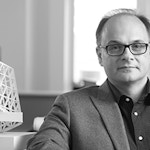Optimized Adaptive Re-Use
Computational Workflows Towards Net-Zero Carbon Buildings
Presented on August 26, 2020 at Facade Tectonics 2024 World Congress
Sign in and Register
Create an Account
Overview
Abstract
Contemporary building practice represents a disconnect between traditional manufacturing techniques, that favor straight runs and orthogonal geometries, and the fact that a building’s geometry can have significant impacts on its overall energy consumption. This is evidenced by the fact that high-performance facades typically attempt to increase energy efficiency through new materials and technologies with little regard for a facade’s formal characteristics and the impact form can have on decreasing a building’s energy requirements. This problem is further exaggerated when retrofitting a 1960’s concrete structure with a high-performance facade intended to achieve Net-Zero Carbon.
The University of Calgary’s MacKimmie Tower, a 12 storey 1960’s brutalist tower was originally designed as the campus library. With its precast facade reaching the end of its usable life, and the building’s programming no longer effective to house a contemporary library, the building was slated for demolition. Through a rigorous evaluation of the tower’s embodied energy, combined with the volume of waste material produced if fully demolished, the most viable strategy to achieve the campus’ sustainable initiatives was to preserve the concrete structure and outfit it with a high-performance double-skin operable facade.
This paper illustrates how the use of computation and simulation facilitated the design, optimization and fabrication of the tower’s high-performance facade. Specifically, this paper will demonstrate how simplified geometry was mobilized to facilitate interdisciplinary and interwoven computational workflows towards the design and realization of the tower’s faceted, radiused and tapered formal qualities. Additionally, this research will evidence the role of the facade towards achieving the Canadian Green Building Council’s (CaGBC) Zero Carbon Building – Design (ZCBD) and Zero Carbon Building – Performance (ZCBP).
Authors

Matthew Parker
Intern Architect
Dialog Design
matthewparker@dialogdesign.ca

John Souleles
Principal
jsouleles@dialogdesign.ca
Keywords
Introduction
Embodied energy, the total energy required for the extraction, processing, manufacturing and delivery of building materials to the building site, can account for up to 20% of a building’s overall
Access Restricted
The Case for and the Challenges of Adaptive Re-use
The average building in North America is less than 50 years old when demolished, despite many being designed for functional lifespans well beyond 75 years (O’Conner 2004). Compounded by the
Access Restricted
Methodology: Towards Simplified Complexity
From the outset of design, it was paramount to understand the historic conditions of the tower and necessary performance criteria to achieve the mandated objectives. The development of these objectives
Access Restricted
Computational Optimization
Once the general massing was established and energy simulations yielded results contained within an accept range of tolerance (EUI ratings less than 80 kWh/m2/year), the newly formalized MDS served as
Access Restricted
Constructions and Fabrications
The wireframe network that facilitated the façade’s optimization served as agile geometry that now described the MDS and could be further mobilized towards the construction and fabrication of the glazed
Access Restricted
Conclusion and Future Work
With respect to the performance criteria set out for the high-performance façade, the most recent energy modeling has the façade exceeding anticipated performance criteria. Preliminary studies of the historic MacKimmie
Access Restricted
Acknowledgements
DIALOG would like to acknowledge The University of Calgary for their guidance and support, our comprehensive consultant team inclusive Transsolar Klimate Engineering, Entuitive structural engineers, DIALOG mechamical engineering, SMP electrical engineering, Ferguson Glass, HUECK Germany, Siemens, Stuart Olson Construction and many others for their tireless support in the creation of the facade concept.
Rights and Permissions
Aksamija, Ajla. "Regenerative Design and Adaptive Reuse of Existing Commercial Buildings for Net-zero Energy Use." Sustainable Cities and Society 27 (2016): 185-95.
Bullen, and Love. "The Rhetoric of Adaptive Reuse or Reality of Demolition: Views from the Field." Cities 27, no. 4 (2010): 215-24.
Fineout, Matthew. “Form as Energy: The building envelope as an expression of energy.” Proceedings of the Facade Tectonics 2018 World Congress, Volume 1. Los Angeles (2018): 37-46.
Fluhrer, Caroline, Maurer, Eric, and Deshmukh, Aalok. "Achieving Radically Energy Efficient Retrofits: The Empire State Building Example. (Report)." ASHRAE Transactions 116, no. 2 (2010): 236.
Gaspar, L. Santos, A. “Embodied Energy on Refurbishment vs. Demolition: A Southern Europe Case Study.” Energy and Buildings 87, (2014) 389-394
Glymph, Shelden, Ceccato, Mussel, and Schober. "A Parametric Strategy for Free-form Glass Structures Using Quadrilateral Planar Facets." Automation in Construction 13, no. 2 (2004): 187-202.
Hachem, and Elsayed. "Patterns of Facade System Design for Enhanced Energy Performance of Multistory Buildings." Energy & Buildings 130 (2016): 366-77.
Häkkinen, T. "Assessment of Indicators for Sustainable Urban Construction." Civil Engineering and Environmental Systems 24, no. 4 (2007): 247-59.
O’Connor, Jennifer. “ Survey on actual service lives for North American buildings.” Woodframe Housing Durability and Disaster Issues Conference (2004).
Olgyay, Victor, Seruto Cherlyn. “Whole-Building Retrofits: A Gateway to Climate Stabilization.” ASHRAE Transactions 116 (2010)
Pena De Leon, Alexander. "Two Case-Studies of Freeform-Facade Rationalization." Digital Physicality - Proceedings of the 30th eCAADe Conference 2 (2012).
Ruparathna, Rajeev, Kasun Hewage, and Rehan Sadiq. "Rethinking Investment Planning and Optimizing Net Zero Emission Buildings." Clean Technologies and Environmental Policy 19, no. 6 (2017): 1711-724.
Yung, and Chan. "Implementation Challenges to the Adaptive Reuse of Heritage Buildings: Towards the Goals of Sustainable, Low Carbon Cities." Habitat International 36, no. 3 (2012): 352-61.